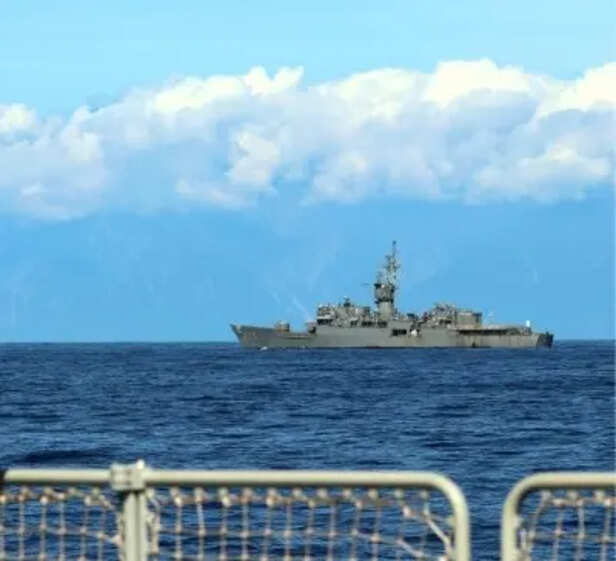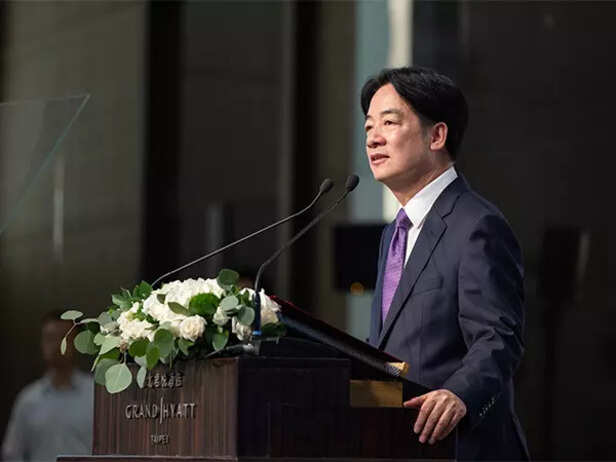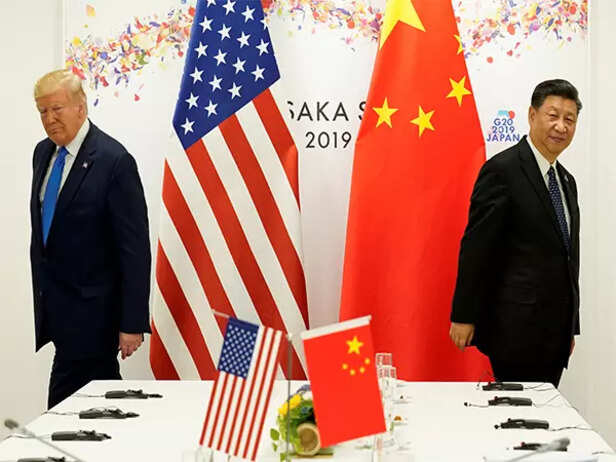Two Aircraft Carriers, 70 Warships, Dozens of Fighter Jets! China Suddenly Assembles Massive Military Presence Near Taiwan
Ushnish Samadder | ANI | Jun 04, 2025, 07:45 IST
( Image credit : ANI, Timeslife )
China ramps up pressure on Taiwan, surrounding it with warships, while also provoking near Japan’s border. The U.S. issues a warning, and Xi Jinping’s government responds swiftly with a counterstatement.
Once again, the former Formosa island faces China's aggressive show of force. A fleet of Chinese warships has encircled the area, raising tensions in Taiwan. International relations experts believe this is a direct challenge to the United States. As a result, there's little doubt that the geopolitical situation in the Pacific region is set to become increasingly complex.
On June 2 this year, a senior official from Taiwan’s military addressed the media about the issue. He revealed that in May, China’s People’s Liberation Army (PLA) Navy surrounded the entire island with two aircraft carriers and at least a dozen warships. From May 1 to 27, Beijing deployed over 70 warships in the Yellow Sea and South China Sea. Gradually, those vessels were later relocated to other areas.
According to the Taiwanese military official, who spoke on condition of anonymity, China is pursuing two main strategies to take control of the island. First, by surrounding Taiwan with its navy, Beijing is trying to exert psychological pressure, hoping to weaken the fighting spirit of the Taiwanese people—something President Xi Jinping reportedly believes will work. Second, he is also attempting, through various means and tactics, to force the island’s political leadership to relinquish control.

Taiwan’s military has reported that Beijing didn’t stop at deploying warships in May. Chinese forces frequently flew fighter jets over the island, many of which were operated from aircraft carriers. Some jets were also launched directly from mainland China. This aggressive posture by Xi Jinping’s military has sparked widespread fear and tension across the island nation.
Citing Taiwanese military sources, The Eurasian Times reported that China deployed warships in the Miyako Strait to block all possible escape routes for the people of Taiwan. This area of the Pacific Ocean, also known as the Kerama Gap, lies between two Japanese islands and holds significant strategic importance—often considered a gateway to the Sea of Japan. Despite objections from Tokyo, China’s navy reportedly ignored the concerns and continued its operations in the region.
According to data from Taiwan’s Ministry of Defense, at least 75 Chinese warplanes violated its airspace in May. Meanwhile, in the Miyako Strait, Chinese warships came face-to-face with Japanese Coast Guard vessels. When Tokyo’s forces ordered the PLA Navy to withdraw, they refused, leading to a tense standoff. During this time, Japan—often referred to as the "Land of the Rising Sun"—also accused Beijing of repeated airspace violations in the Pacific region.

On May 20 last year, Lai Ching-te was sworn in as President of Taiwan. To mark the anniversary, a special event was held in the capital, Taipei. The timing of China’s naval encirclement of the island during this occasion is being seen as highly significant. However, Taiwan’s political leadership—formerly of the island known as Formosa—has yet to issue any official statement on the matter.
Meanwhile, at Singapore’s Shangri-La Security Dialogue, U.S. Defense Secretary Pete Hegseth spoke out on the issue. He stated, “China is trying to upset the balance of power among Asian countries and has been issuing constant threats. These threats should not be taken lightly, as they could become even more dangerous in the future.”
At the Shangri-La Security Dialogue, Pete did not hold back in targeting the Dragon. He openly accused China of attempting to seize Taiwan. According to him, “This will deal a severe blow to the countries in the Indo-Pacific region. Not only that, but the entire world will also suffer the consequences.”
To protect themselves from the aggressive Dragon, Pete advised America’s allies in the region to increase their spending on security. He also made it clear that the United States stands with them now and will continue to do so. The U.S. Defense Secretary emphasized that while Donald Trump was in office, China could never succeed in seizing Taiwan.
After Pete’s remarks, Beijing responded strongly. The Chinese Embassy in Singapore issued a statement saying, “Pete Hegseth has repeatedly criticized and attacked our country. In reality, the United States itself is the biggest threat to regional peace and stability!” Following this, Beijing warned Washington not to play with fire.

Senior officials from Taiwan’s government offices have claimed that there was a time when it felt China could invade with troops at any moment. They have somewhat accepted that without external support, it would be impossible to defend against attacks from all sides. On May 15, retired U.S. Navy Rear Admiral Mark Montgomery outlined how dangerous China’s mindset can be in an article titled “The Communist Party of China’s (CPC) Aggression Against Taiwan.”
In the related report, Mark wrote that the U.S. must rapidly increase troop numbers at its bases in the Pacific region. Where 500 troops are currently deployed, that number should be raised to a thousand. The United States should immediately provide Taiwan with billions of dollars’ worth of advanced military equipment. This would enable Taiwan to initially push back against China. This period of resistance is crucial during wartime. If the entire island falls into the hands of the Dragon’s forces before help arrives, retaking it would be extremely difficult.
China is unwilling to recognize Taiwan as a separate country. Beijing considers the Pacific island nation an inseparable part of its territory. A few years ago, China’s president and CPC chairman Xi made a bold statement on this issue, saying, “No one can stop the process of Taiwan reuniting with China.”
Defense analysts believe that China aims to seize Taiwan in order to gain full control over the Pacific region. They think that if Beijing succeeds, it will become difficult for the United States to maintain a presence there. Currently, the Dragon challenges the U.S. across nearly all fields—including the economy, military, and space research. As a result, no one is dismissing the possibility of a direct conflict between the two superpowers in the near future.
Explore the latest trends and tips in Health & Fitness, Travel, Life Hacks, Fashion & Beauty, and Relationships at Times Life!
On June 2 this year, a senior official from Taiwan’s military addressed the media about the issue. He revealed that in May, China’s People’s Liberation Army (PLA) Navy surrounded the entire island with two aircraft carriers and at least a dozen warships. From May 1 to 27, Beijing deployed over 70 warships in the Yellow Sea and South China Sea. Gradually, those vessels were later relocated to other areas.
According to the Taiwanese military official, who spoke on condition of anonymity, China is pursuing two main strategies to take control of the island. First, by surrounding Taiwan with its navy, Beijing is trying to exert psychological pressure, hoping to weaken the fighting spirit of the Taiwanese people—something President Xi Jinping reportedly believes will work. Second, he is also attempting, through various means and tactics, to force the island’s political leadership to relinquish control.

Taiwan detects 'massive' Chinese military presence in region
( Image credit : IANS )
Taiwan’s military has reported that Beijing didn’t stop at deploying warships in May. Chinese forces frequently flew fighter jets over the island, many of which were operated from aircraft carriers. Some jets were also launched directly from mainland China. This aggressive posture by Xi Jinping’s military has sparked widespread fear and tension across the island nation.
Citing Taiwanese military sources, The Eurasian Times reported that China deployed warships in the Miyako Strait to block all possible escape routes for the people of Taiwan. This area of the Pacific Ocean, also known as the Kerama Gap, lies between two Japanese islands and holds significant strategic importance—often considered a gateway to the Sea of Japan. Despite objections from Tokyo, China’s navy reportedly ignored the concerns and continued its operations in the region.
According to data from Taiwan’s Ministry of Defense, at least 75 Chinese warplanes violated its airspace in May. Meanwhile, in the Miyako Strait, Chinese warships came face-to-face with Japanese Coast Guard vessels. When Tokyo’s forces ordered the PLA Navy to withdraw, they refused, leading to a tense standoff. During this time, Japan—often referred to as the "Land of the Rising Sun"—also accused Beijing of repeated airspace violations in the Pacific region.

Taiwan President Lai Ching-te
( Image credit : ANI )
On May 20 last year, Lai Ching-te was sworn in as President of Taiwan. To mark the anniversary, a special event was held in the capital, Taipei. The timing of China’s naval encirclement of the island during this occasion is being seen as highly significant. However, Taiwan’s political leadership—formerly of the island known as Formosa—has yet to issue any official statement on the matter.
Meanwhile, at Singapore’s Shangri-La Security Dialogue, U.S. Defense Secretary Pete Hegseth spoke out on the issue. He stated, “China is trying to upset the balance of power among Asian countries and has been issuing constant threats. These threats should not be taken lightly, as they could become even more dangerous in the future.”
At the Shangri-La Security Dialogue, Pete did not hold back in targeting the Dragon. He openly accused China of attempting to seize Taiwan. According to him, “This will deal a severe blow to the countries in the Indo-Pacific region. Not only that, but the entire world will also suffer the consequences.”
To protect themselves from the aggressive Dragon, Pete advised America’s allies in the region to increase their spending on security. He also made it clear that the United States stands with them now and will continue to do so. The U.S. Defense Secretary emphasized that while Donald Trump was in office, China could never succeed in seizing Taiwan.
After Pete’s remarks, Beijing responded strongly. The Chinese Embassy in Singapore issued a statement saying, “Pete Hegseth has repeatedly criticized and attacked our country. In reality, the United States itself is the biggest threat to regional peace and stability!” Following this, Beijing warned Washington not to play with fire.

President of China Xi Jinping
( Image credit : ANI )
Senior officials from Taiwan’s government offices have claimed that there was a time when it felt China could invade with troops at any moment. They have somewhat accepted that without external support, it would be impossible to defend against attacks from all sides. On May 15, retired U.S. Navy Rear Admiral Mark Montgomery outlined how dangerous China’s mindset can be in an article titled “The Communist Party of China’s (CPC) Aggression Against Taiwan.”
In the related report, Mark wrote that the U.S. must rapidly increase troop numbers at its bases in the Pacific region. Where 500 troops are currently deployed, that number should be raised to a thousand. The United States should immediately provide Taiwan with billions of dollars’ worth of advanced military equipment. This would enable Taiwan to initially push back against China. This period of resistance is crucial during wartime. If the entire island falls into the hands of the Dragon’s forces before help arrives, retaking it would be extremely difficult.
China is unwilling to recognize Taiwan as a separate country. Beijing considers the Pacific island nation an inseparable part of its territory. A few years ago, China’s president and CPC chairman Xi made a bold statement on this issue, saying, “No one can stop the process of Taiwan reuniting with China.”
Defense analysts believe that China aims to seize Taiwan in order to gain full control over the Pacific region. They think that if Beijing succeeds, it will become difficult for the United States to maintain a presence there. Currently, the Dragon challenges the U.S. across nearly all fields—including the economy, military, and space research. As a result, no one is dismissing the possibility of a direct conflict between the two superpowers in the near future.
Explore the latest trends and tips in Health & Fitness, Travel, Life Hacks, Fashion & Beauty, and Relationships at Times Life!
